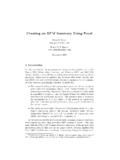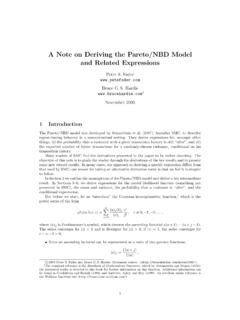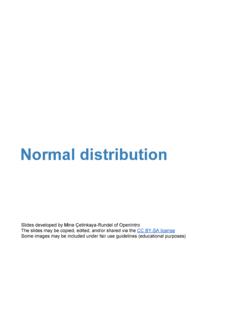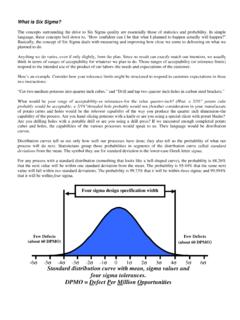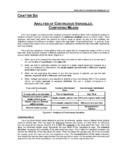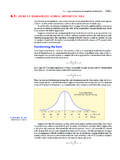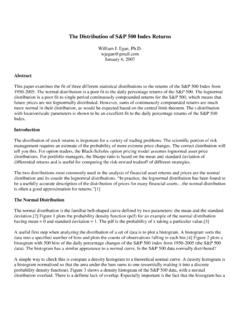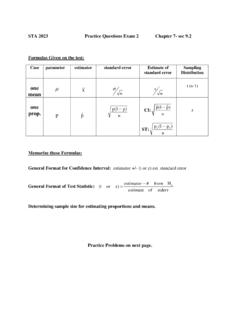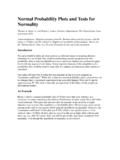Transcription of Probability Models for Customer-Base Analysis - …
1 Probability Models for customer -BaseAnalysisPeter S. FaderUniversity of HardieLondon Business Annual Advanced Research Techniques ForumJune 14 17, 2009 2009 Peter S. Fader and Bruce G. S. Hardie1 Agenda Introduction to Customer-Base Analysis The right way to think about computing CLV Review of Probability Models Models for contractual settings Models for noncontractual settings The BG/BB model The Pareto/NBD model The BG/NBD model Beyond the basic models2 Customer-Base Analysis Faced with a customer transaction database, we maywish to determine which customers are most likely to be active in thefuture, the level of transactions we could expect in futureperiods from those on the customer list, bothindividually and collectively, and individual customer lifetime value (CLV).
2 Forward-looking/predictive versus of Modelling Approaches- PastFuturelatentcharacteristics( )66 Traditional approachfuture =f(past) Probability modelling approach =f(past)- future =f( )4 Classifying Analysis SettingsConsider the following two statements regarding the size ofacompany s customer base : Based on numbers presented in a January 2008 pressrelease that reported Vodafone Group Plc s third quarterkey performance indicators, we see that Vodafone UK million pay monthly customers. In his Q4 2007 Financial Results Conference Call , the CFOof Amazon made the comment that [a]ctive customeraccounts exceeded 76 million, up 19% where alive customeraccounts represent customers who ordered in the past Analysis Settings It is important to distinguish between contractual andnoncontractual settings: In acontractualsetting, we observe the time atcustomers become inactive.
3 In anoncontractualsetting, the time at which a customerbecomes inactive is unobserved. The challenge of noncontractual markets:How do we differentiate between those customerswho have ended their relationship with the firmversus those who are simply in the midst of a longhiatus between transactions?6 Classifying Analysis SettingsConsider the following four specific business settings: Airport VIP lounges Electrical utilities Academic conferences Mail-order clothing customer BasesGrocery purchasesDoctor visitsHotel staysCredit cardStudent mealplanMobile phone usageEvent attendancePrescription refillsCharity fund drivesMagazine subsInsurance policyHealth club m shipContinuousDiscreteOpportunities forTransactionsNoncontractualContractual Type of Relationship With Customers8 The Right Way to Think About ComputingCustomer Lifetime Value9 Calculating CLVC ustomer lifetime value isthe present value of the futurecash flows associated with the customer .
4 A forward-looking concept Not to be confused with (historic) customerprofitability10 Calculating CLVS tandard classroom formula:CLV=T t=0mrt(1+d)twherem= net cash flow per period (if active)r= retention rated= discount rateT= horizon for calculation11 CalculatingE(CLV)A more correct starting point:E(CLV)= 0E[v(t)]S(t)d(t)dtwhereE[v(t)]= expected value (or net cashflow) of thecustomer at timet(if active)S(t)= the Probability that the customer hasremained active to at least timetd(t)= discount factor that reflects thepresent value of money received attimet12 CalculatingE(CLV) Definitional; of little use by itself. We must operationalizeE[v(t)],S(t), andd(t)in aspecific business setting.
5 Then solve the integral. Important distinctions: Expected lifetime value of an as-yet-to-be-acquiredcustomer Expected lifetime value of a just-acquired customer Expectedresiduallifetime value,E(RLV), of anexisting customer13 CalculatingE(CLV) The expected lifetime value of an as-yet-to-be-acquiredcustomer is given byE(CLV)= 0E[v(t)]S(t)d(t)dt Standing at timeT, the expected residual lifetime valueof an existing customer is given byE(RLV)= TE[v(t)]S(t|t > T )d(t T )dt14 Review of Probability Models15 The Logic of Probability Models Many researchers attempt to describe/predict behaviorusing observed variables. However, they still use random components inrecognition that not all factors are included in themodel.
6 We treat behavior as if it were random (probabilistic,stochastic). We propose a model of individual-level behavior whichis summed across heterogeneous individuals toobtain a model of aggregate a Probability model (i) Determine the marketing decision problem/information needed.(ii) Identify theobservableindividual-level behavior ofinterest. We denote this byx.(iii) Select a Probability distribution that characterizesthis individual-level behavior. This is denoted byf (x| ). We view the parameters of this distribution asindividual-levellatent a Probability model (iv) Specify a distribution to characterize thedistribution of the latent trait variable(s) acrossthe population.
7 We denote this byg( ). This is often called themixing distribution.(v) Derive the correspondingaggregateorobserveddistribu tion for the behavior of interest:f (x)= f (x| )g( ) d 18 Building a Probability model (vi) Estimate the parameters (of the mixingdistribution) by fitting the aggregate distributionto the observed data.(vii) Use the model to solve the marketing decisionproblem/provide the required Classes of Models We focus on three fundamental behavioral processes: Timing- when Counting- how many Choice - whether/which Our toolkit contains simple Models for each behavioralprocess. More complex behavioral phenomena can be capturedby combining Models from each of these Building BlocksCount data arise from asking the question, How many?
8 As such, they are non-negative integers with no the random variableXbe a count variable:Xis distributed Poisson with mean ifP(X=x| )= xe x!, x=0,1,2, ..21 Individual-level Building BlocksTiming (or duration) data are generated by answering when and how long questions, asked with regards to aspecific event of Models we develop for timing data are alsoused to model other non-negative continuousquantities ( , transaction value).Let the random variableTbe a timing variable:Tis distributed exponential with rate parameter ifF(t| )=P(T t| )=1 e t, t > Building BlocksA Bernoulli trial is a probabilistic experiment in whichthere are two possible outcomes, success (or 1 ) and failure (or 0 ), where is the Probability of Bernoulli trials lead to Building BlocksLet the random variableXbe the number of independentand identically distributed Bernoulli trials required untilthe first success:Xis a (shifted) geometric random variable, whereP(X=x| )= (1 )x 1, x=1,2,3.
9 The (shifted) geometric distribution can be used to modeleitheromitted-zero class count dataordiscrete-timetiming Building BlocksLet the random variableXbe the total number ofsuccesses occurring innindependent and identicallydistributed Bernoulli trials:Xis distributed binomial with parameter , whereP(X=x|n, )=(nx) x(1 )n x, x=0,1,2, .. , n .We use the binomial distribution to model repeated choicedata answers to the question, How many times did aparticular outcome occur in a fixed number of events? 25 Capturing Heterogeneity in Latent TraitsThe gamma distribution:g( |r , )= r r 1e (r ), >0 ( )is the gamma function ris the shape parameter and is the scale parameter The gamma distribution is a flexible (unimodal)distribution.
10 And is mathematically Gamma Density Functions0123 ( )..r= , = , = , =10123 , = , = , =427 Capturing Heterogeneity in Latent TraitsThe beta distribution:g( | , )= 1(1 ) 1B( , ),0< <1. B( , )is the beta function, which can be expressed interms of gamma functions:B( , )= ( ) ( ) ( + ) The beta distribution is a flexible distribution .. and ismathematically convenient28 Illustrative Beta Density 0123g( ).. =5, = .. =1, = = , = = , = = , = =2, =429 The Negative Binomial Distribution (NBD) The individual-level behavior of interest can becharacterized by the Poisson distribution when themean is known. We do not observe an individual s but assume it isdistributed across the population according to agamma (X=x|r , )= 0P(X=x| )g( |r , )d = (r+x) (r )x!

